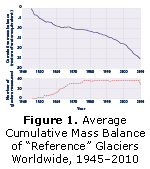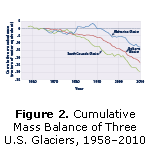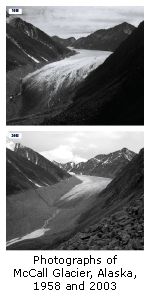Climate Change
Climate Change Indicators in the United States
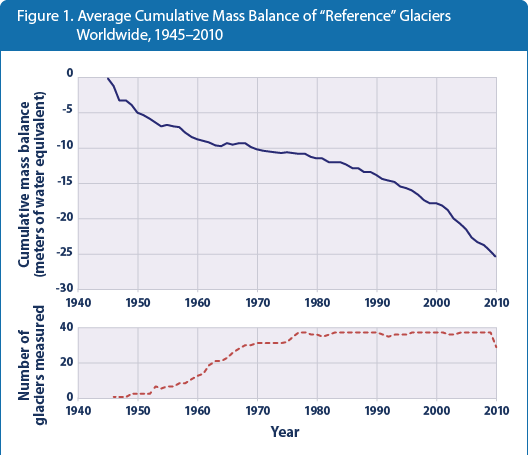
This figure shows the cumulative change in mass balance of a set of "reference" glaciers worldwide beginning in 1945. The line on the graph represents the average of all the glaciers that were measured. Negative values in later years indicate a net loss of ice and snow compared with the base year of 1945. For consistency, measurements are in meters of water equivalent, which represent changes in the average thickness of a glacier. The small chart below shows how many glaciers were measured in each year. Some glacier measurements have not yet been finalized for 2010, hence the smaller number of sites.
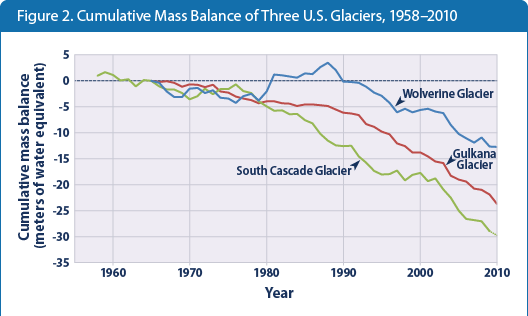
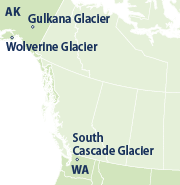 This figure shows the cumulative mass balance of the three U.S. Geological Survey "benchmark" glaciers since measurements began in the 1950s or 1960s. For each glacier, the mass balance is set at zero for the base year of 1965. Negative values in later years indicate a net loss of ice and snow compared with the base year. For consistency, measurements are in meters of water equivalent, which represent changes in the average thickness of a glacier. The dashed line in the lower right corner represents a preliminary number for 2010.
This figure shows the cumulative mass balance of the three U.S. Geological Survey "benchmark" glaciers since measurements began in the 1950s or 1960s. For each glacier, the mass balance is set at zero for the base year of 1965. Negative values in later years indicate a net loss of ice and snow compared with the base year. For consistency, measurements are in meters of water equivalent, which represent changes in the average thickness of a glacier. The dashed line in the lower right corner represents a preliminary number for 2010.
Data source: USGS, 2012 5
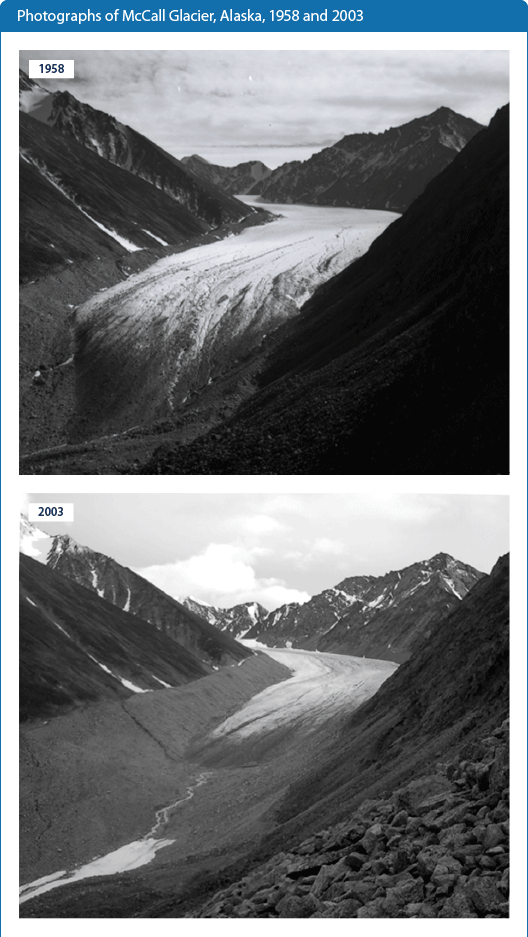
Key Points
- On average, glaciers worldwide have been losing mass since at least the 1970s (see Figure 1), which in turn has contributed to observed changes in sea level (see the Sea Level indicator). Measurements from a smaller number of glaciers suggest that they have been shrinking since the 1940s. The rate at which glaciers are losing mass appears to have accelerated over roughly the last decade.
- All three U.S. benchmark glaciers have shown an overall decline in mass balance since the 1950s and 1960s and an accelerated rate of decline in recent years (see Figure 2). Year-to-year trends vary, with some glaciers gaining mass in certain years (for example, Wolverine Glacier during the 1980s). However, most of the measurements indicate a loss of glacier mass over time.
- Trends for the three benchmark glaciers are consistent with the retreat of glaciers observed throughout the western United States, Alaska, and other parts of the world. 2 Observations of glaciers losing mass are also consistent with warming trends in U.S. and global temperatures during this time period (see the U.S. and Global Temperature indicator).
Background
A glacier is a large mass of snow and ice that has accumulated over many years and is present year-round. In the United States, glaciers can be found in the Rocky Mountains, the Sierra Nevada, the Cascades, and throughout Alaska. A glacier flows naturally like a river, only much more slowly. At higher elevations, glaciers accumulate snow, which eventually becomes compressed into ice. At lower elevations, the “river” of ice naturally loses mass because of melting and ice breaking off and floating away (iceberg calving) if the glacier ends in a lake or the ocean. When melting and calving are exactly balanced by new snow accumulation, a glacier is in equilibrium and its mass will neither increase nor decrease.
In many areas, glaciers provide communities and ecosystems with a reliable source of streamflow and drinking water, particularly in times of extended drought and late in the summer, when seasonal snowpack has melted away. Freshwater runoff from glaciers also influences ocean ecosystems. Glaciers are important as an indicator of climate change because physical changes in glaciers—whether they are growing or shrinking, advancing or receding—provide visible evidence of changes in temperature and precipitation. If glaciers lose more ice than they can accumulate through new snowfall, they ultimately add more water to the oceans, leading to a rise in sea level (see the Sea Level indicator). The same kinds of changes occur on a much larger scale within the giant ice sheets that cover Greenland and Antarctica, potentially leading to even bigger implications for sea level. Small glaciers tend to respond more quickly to climate change than the giant ice sheets, however, and they have added more water to the oceans than the ice sheets have in recent decades. 1
About the Indicator
This indicator is based on long-term monitoring data collected at selected glaciers around the world. Scientists collect detailed measurements to determine glacier mass balance, which is the net gain or loss of snow and ice over the course of the year. A negative mass balance indicates that a glacier has lost ice or snow. The cumulative mass balance over time reveals long-term trends. For example, if cumulative mass balance becomes more negative over time, it means glaciers are losing mass more quickly than they can accumulate new snow.
Figure 1 shows trends in mass balance for a set of 37 reference glaciers around the world that have been measured consistently since the 1970s, including a few that have been measured since the 1940s. Data from these reference glaciers have been averaged together to depict changes over time. Figure 2 shows trends for three "benchmark" glaciers: South Cascade Glacier in Washington state, Wolverine Glacier near Alaska’s southern coast, and Gulkana Glacier in Alaska’s interior. These three glaciers were chosen because they have been studied extensively by the U.S. Geological Survey for many years and because they are thought to be representative of other glaciers nearby.
This indicator describes the change in glacier mass balance, which is measured as the average change in thickness across the surface of a glacier. The change in ice or snow has been converted to the equivalent amount of liquid water.
Indicator Notes
The relationship between climate change and glacier mass balance is complex, and the observed changes at specific reference or benchmark glaciers might reflect a combination of global and local climate variations. Slightly different measurement and analysis methods have been used at different glaciers, but overall trends appear to be similar.
Long-term measurements are available for only a relatively small percentage of the world’s glaciers. This indicator does not include the Greenland and Antarctic ice sheets, although nearly two decades of satellite data suggest that these ice sheets are also experiencing a net loss of ice. 8 Continued satellite data collection will allow scientists to evaluate long-term trends in the future.
Data Sources
The World Glacier Monitoring Service compiled data for Figure 1, based on measurements collected by a variety of organizations around the world. The U.S. Geological Survey Benchmark Glacier Program provided the data for Figure 2. These data, as well as periodic reports and measurements of the benchmark glaciers, are available on the program’s website at: http://ak.water.usgs.gov/
glaciology.
Technical Documentation
- Download related technical information PDF (7 pp, 154K)



